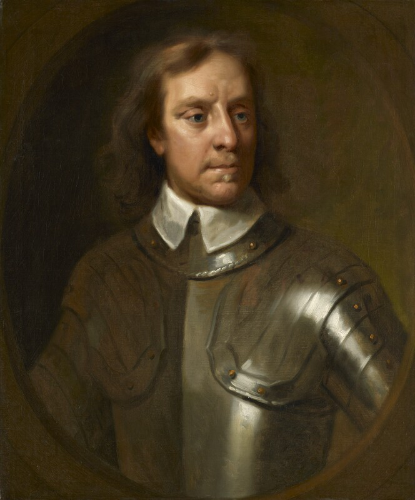25th April 2019
On this day in 1599, 420 years ago, Oliver Cromwell was born in Huntingdon, Cambridgeshire to a respectable but not wealthy family. In Cromwell’s own words: ‘I was by birth a gentleman, living neither in considerable height, nor yet in obscurity.’ While not a direct descendant of Thomas Cromwell, Henry VIII’s chief minister, Oliver did have a family connection – his great-great-grandfather Morgan Williams married Thomas’ sister Katherine Cromwell. Their sons took the name Cromwell to honour their childless uncle and continue the family name.
Little is known of Oliver’s early years. He attended Sidney Sussex College, Cambridge but left a year later without obtaining a degree after the death of his father. As the only surviving son, Oliver was forced to return home to support his mother and seven unmarried sisters. At the age of twenty-one, Cromwell married Elizabeth Bourchier, the daughter of a London fur trader with extensive land in Essex. Oliver and Elizabeth had a long and stable marriage and went on to have nine children, six of whom survived into adulthood. Elizabeth was noted for her discretion and loyalty to Oliver and letters between the two in the 1650’s appear to show a deep affection.
Cromwell became an MP for Huntingdon in 1628, and around the same time appeared to go through a personal crisis of sorts – likely depression. Possibly as a result of this personal crisis, Cromwell also experienced a major religious conversion at this time, becoming a deeply religious Puritan – a change that would dominate the rest of his life.
The parliament of 1628-29 was the last one to be called for eleven years, as this was the period of Charles I’s personal rule. When Charles was finally forced to recall parliament in 1640, Cromwell once again stood as an MP in both the Short and Long Parliaments that followed.
It was when armed conflict broke out between the king and parliament that Cromwell began to distinguish himself. Despite his lack of formal training, he proved himself to be a capable military leader. Cromwell understood the importance of both training and discipline, expecting high moral standards from his men. He rose through the ranks, and was given command of his own cavalry. Cromwell cemented his reputation at the Battle of Marston Moor in 1644, when he defeated Prince Rupert of the Rhine, nephew of Charles I and effectively put the north of England under parliamentary control. He was also involved in the formation of the New Model Army in 1645, and was quickly promoted to second-in-command. The disciplined, formidable New Model Army helped to turn the tide and win the civil war for the Parliamentarians.
Success had made Cromwell powerful. He was one of the fifty-nine MPs who signed Charles I’s death warrant – his signature was third on the list. When Charles I was executed in January 1649 and the monarchy abolished, England was declared a Commonwealth. Cromwell was appointed a member of the Council of State, which replaced the king and his privy council.
Both Ireland and Scotland remained a threat to this new government. Cromwell led a brutal campaign to pacify the Irish and then later went to restore order in Scotland when the Scots proclaimed Charles II as king. He defeated Charles II’s army, sending him into exile again and finally bringing an end to the English Civil Wars.
But divisions were forming in parliament. The army was growing discontented with the new government, while parliament was wary of the army’s power. Charles I, their common enemy, had been defeated and now they could no longer put aside their disagreements to rule the country. Cromwell returned from his Scottish campaign and grew frustrated at parliament looking out for its own interest – eventually deciding it must be replaced by a less corrupt one. In April 1653 he led some of his men into the Commons Chamber, dissolving parliament by force and replacing it with an assembly mostly made up of army high command. Later that year he was made Lord Protector – essentially becoming king in all but name.
But like Charles I before him, Cromwell found Parliament difficult to handle. He still had too many enemies and they blocked the legislation he wanted to introduce. He also had to contend with a rebellion in 1655 and after suppressing it, Cromwell attempted to control the press and prevent public debate. He dismissed parliament and appointed major-generals to oversee the English provinces – an action not supported by parliament. One of the aims of the major-generals was to improve the moral character of England and make it a more godly country. They were, unsurprisingly, very unpopular.
Cromwell was offered the crown and title of king – there was still a desire for a hereditary head of state. But he refused this. By 1658 Cromwell’s health had started to decline, and he died in September of that year and was buried at Westminster after a lavish funeral. His son Richard briefly took over as Lord Protector, but he was an inefficient leader with little support and was forced to resign in 1659. With no leader among the various factions, Charles II was invited back from exile to take the throne left empty since his father’s execution and the monarchy was restored. The new king had the body of Cromwell exhumed and posthumously executed. His head was cut off and remained on a spike outside Westminster Hall until 1685.

Image: Oliver Cromwell, after Samuel Cooper, based on a work of 1656, NPG 514, © National Portrait Gallery, London.